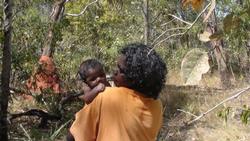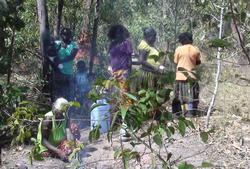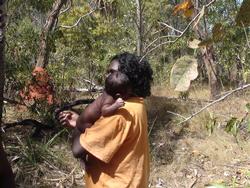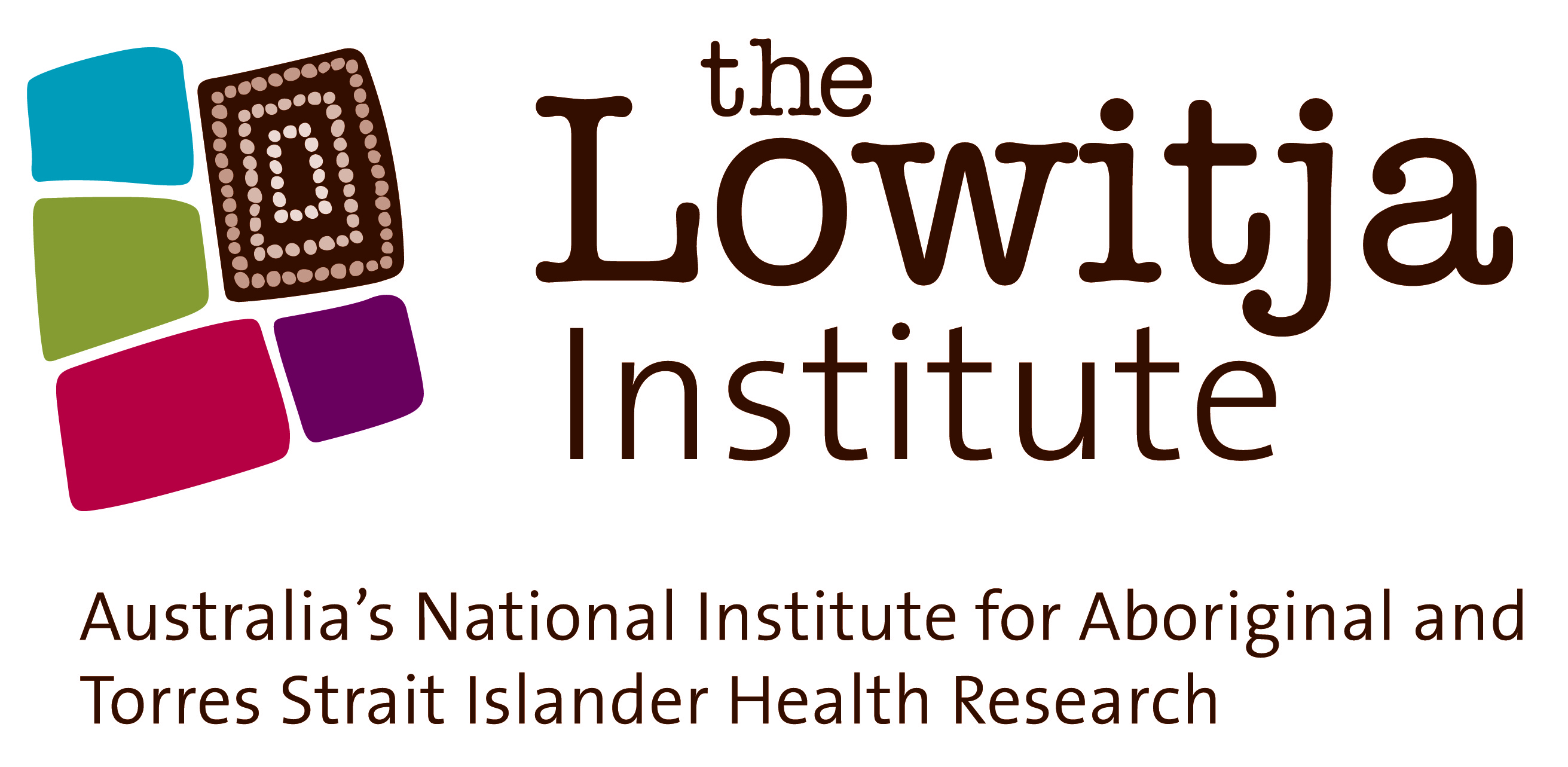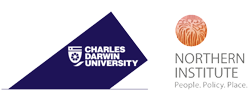Helping children become strong
As well as helping language grow stronger, Yolŋu support development of physical strength, strong cultural values and practice and emotional resilience in many different ways. Below are just a few examples.
Ceremony for mothers and their newborn babies to make them strong: dhudi-gothan
Soon after birth it is still common for the mother and child to participate in a 'smoking ceremony' - dhudi-gothan. This is a traditional ritual or ceremony for women to enable the maturity process - physically, spiritually and mentally. This smoking ceremony is done to help heal the mother after the birth and to make the baby healthy.This process also strengthens the mother to face motherhood with confidence in how to raise the child. In the past this ceremony was done straight after birth. Now most mothers give birth away from the community and so the ceremony is delayed until after they return - it might be two or three weeks after birth or sometimes not at all. This ceremony is highly valued by many Yolŋu who want it to continue.
That's one of the Yolŋu ways of (promoting) health and wellbeing for our children.....that's very important - to have that smoking ceremony for children - babies especially. Because they need to grow up and be strong and to have that strong spirit. Yes. And it can take them to have good behaviour and intelligence and wellbeing, into education - our world. Yes. And that is very important. That's why I teach my own daughters - and passing that knowledge to our sons, our daughters, so they'll have to be in that same step. It can't.. fade away (Murimuri's grandmother)
The mother and child are taken to a quiet private area in the bush away from men by a Yolŋu 'midwife' - an expert in Yolŋu care for mothers and babies - now often someone who works for the Strong Women, Strong Culture, Strong Babies Program (see more information about this Program here).
The helper (midwife) would take the child off the mother.. just for a short while after preparing a small steamy smoky fire pit, a temporary one... The heat is very hot and the coals in the fire pit (with) a certain kind of grass, not just any grass from the bushes, but grass from the water, so the combination can be best with the coals, fire and grass from the fresh water.
After warming her hands over the steamy smoke, she’d place her hands on the child’s nose and feet... And massage the child's feet and the head to straighten it out and the arms, massage them to relax them with the warmth of the fire. Because the child is born too fragile, so the warmth of the heat gives the child strength and flexibility in its arms, knees and thighs. Also the head, nose and finger nails are massaged. Once this heat massaging therapy is done, the child is then handed back to its mother’s arms, just to hold the child, even if it cries, but not yet give it any breast milk at this stage. And after having it done, the child will start to cry for breast milk. This process also helps with the supply of milk to flow from the breasts (Yolŋu Elder Dorothy Bepuka Garrawitja).
When a mother has a lot of breast milk she might use it to wash the baby to make their skin strong and healthy. Breastmilk is also used for eye infections and for ear infections.
This ceremony is also the first stage of learning for the baby:
That’s where it starts, through that process to learn about the mothers care... A Yolŋu child learns first of all, when it is born, when the mother holds her child in her arms. Feeling nurtured by it's mother (Gundjarranbuy, Yolŋu researcher)
This is the first step in the process of teaching the child about the right way to behave as a Yolŋu (raypirri).
At the same time they talk with the baby... Mother, grandmother, mother's side, father's side, family members go and encourage that young woman and the baby. We make the baby sit, make the steam go in too... so he has this warmness inside to make the baby grow strong. At the same time - talk to them: ‘be warrior, be strong and be healthy, eat right food, go for hunting, walking' - same kind of talking, the grandmother has to talk like that (Ḻäwurrpa Maypilama, Yolŋu researcher).
Raypirri at the same time. When we put that baby around that steam... we say ‘when you grow up you will be a good child - you have to visit your parents, obey your parents', that's how we say to that child (Murimuri's grandmother).
Yolŋu also have other ceremonies for teaching children about the right way to behave as Yolŋu (raypirri) - at particular times in their development or when their behaviour shows there is a need for such education.
Helping children learn to walk
Heat from a fire is also used to help children's physical development. When children are at a stage where families assess that they are ready to walk a hot sand massage might be done to help give them strength to start walking.
Hot sand massage is also a treatment used with older people who are experiencing pain or mobility problems. In the video below, Murimuri's grandmother and mother demonstrate and explain the hot sand massage they are doing for Murimuri when she is 12 months old.
Family members also help children learn to walk through verbal encouragement and practice:


